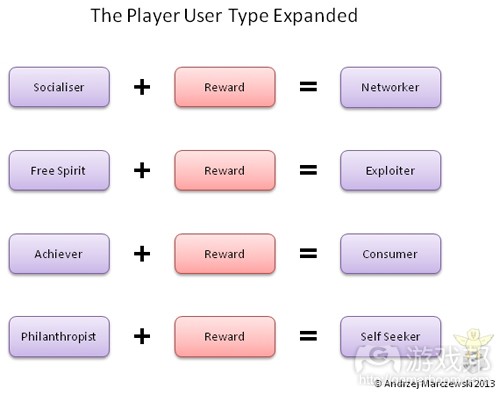Marczewski阐述游戏化用户新分类法
作者:Andrzej Marczewski
用户类型2.0
我曾试图简化和提升我的游戏化用户类型。这第2个版本已经比原来更深入。经过更多调查和研究了他人调查之后,我总结了一些新结论。
四种基本类型:成就者、社交家、慈善家和自由者的归类确实具有可取之处。我认为外向型(消费者、沟通者、自我探索者和开拓者)的分类也还可以,但是它们会给人们造成不少困惑。我太过于极端化了,人们似乎把我的内向型和外向型玩家视作好坏之分!
所以,我要在此推出新的分类法。这并非意在取代原来的分类,只能算是一种增订版本。
以下就是这种分类的基本示意图。
6种用户类型
从上图可以看到,目前有6种类型。以前的慈善家、成就者、社交家和自由者仍在此列,并且仍然代表4种内在动机类型,不过我们现在还添加了破坏者和玩家这两种类型。这两者也并非新概念,“玩家”最初已经出现于我原来的用户分类中,代表外在动机的用户。“破坏者”是我最近给“消极”用户分类所引进的类型。
用户或系统之间仍有动作和交互之分,不过此时的破坏者和玩家似乎并不局限于某一行为。破坏者在此是向用户和系统执行操作,而玩家则是与用户和系统互动。
表面价值
*社交家的动机是相互关系。他们希望与他人互动并创造社会联系。
*自由者的动机是自主权。他们希望创造和探索。
*成就者的动机是精通掌握。他们希望学习新知识并提升自己,他们想克服挑战。
*慈善家的动机是目标。这一群体是利他主义的希望以某种方式帮助他人,丰富他人的生活。
*玩家的动机是奖励。他们会尽一切所能从系统中搜集奖励。
*破坏者的动机有多种多样,但总体来说他们就是想以直接或间接方式对系统搞破坏。
玩家很乐于“玩”你的游戏,从中搜集点数和奖励。破坏者却并不想从中得到什么,要引起他们的兴趣并不那么简单。
这种情况就像下图所示:
灰色地带
我花了些功夫才意识到这一点,但谈论人们的行为表现时的确不可以用非黑即白来描述。在此更适用的是灰色地带,所以我在新用户类型之间也创造了一些灰色地带。虽然玩家和破坏者可以视为独善其身的用户类型,但也可以视为其他四种类型的变体。
玩家
如果你看过我原来的用户类型描述,就会知道以下四种外向型分类法:
所以玩家对系统奖励感兴趣的特点,可以视为内在动机类型的变体。
破坏者
破坏者也同此理。他们的兴趣是破坏游戏化系统。原因不一而足,这可以视为是一种目的。他们觉得破坏系统具有深远意义,可能是让开发者认识到瑕疵,或者证明该系统出了问题。这也可能是因为自主权。在内在用户类型中,自主权是一种积极的动机、探索和创造力。但是,这也可以视为是玩家试图摆脱系统限制的行为——如果系统中具有你并不喜欢的规则,你怎么可能实现真正的自主权呢?他们在破坏系统的过程中可以精通掌握系统,而这一行为也可以让他们因被人所识而获得一种相互关系。
积极的负面因素
这些都与积极动机有关,但对多数人来说它们可能是两个极端。现在值得我们思索的是“破坏”所带来的现代意义。现在破坏性通常与提升系统有关,这可以通过打破常规和呈现新的改进方式得到体现。
正如我所言,这会创造许多灰色地带。我们不提倡让破坏者一直居于稳定的系统中。如果他们就是爱好无理由地破坏规则,那就要把他们移除出去。否则,就应该将他们视为揭示系统弱点以及改进方法的积极因素。
以上就是我当前的游戏化用户分类。如果你选择采用这个用户分类法,就会发现它更具灵活性,更有助于了解用户动机的灰色地带。(本文为游戏邦/gamerboom.com编译,拒绝任何不保留版权的转载,如需转载请联系:游戏邦)
Marczewski’s Gamification User Types 2.0
by Andrzej Marczewski
The following blog post, unless otherwise noted, was written by a member of Gamasutra’s community.
The thoughts and opinions expressed are those of the writer and not Gamasutra or its parent company.
User Types 2.0
I was trying to simplify and improve my gamification user types. Version 2 is just that and a little more. After more research and the results of mine and others surveys on the matter, I have realised a few things.
The four basic types; Achiever, Socialiser, Philanthropist and Free Spirit are all fine. They work and can be left exactly as they are. I am also happy that the extrinsic types (Consumer, Networker, Self Seeker and Exploiter) are ok, however – they have caused a lot of confusion with people. I made everything a little too black and white – it was as if people saw my intrinsic types and extrinsic types as good and evil!
As such, I offer this new version. It is not a replacement, more an addition. If you are using the current four or even eight types – keep using them, they work just fine! However, this is where my thinking and research has led me, so I wanted to present it here properly.
The image below shows the basics.
Six User Types
As you can see, there are now six names on the board. Philanthropist, Achiever, Socialiser and Free Spirit are still there and still represent the four intrinsic motivations of RAMP, however we now have Disruptor and Player. Neither of these is new, Player was first introduced in my original work on user types as a name for the extrinsically motivated users. Disruptor was introduced recently as my “negative” user type.
There is still a split between action and interacting on users or systems, though this time Disruptor and Player straddle more than one segment. Disruptor is seen here as Acting on users and systems, where Player interacts with users and systems.
Face Value
Socialisers are motivated by Relatedness. They want to interact with others and create social connections.
Free Spirits are motivated by Autonomy. They want to create and explore.
Achievers are motivated by Mastery. They are looking to learn new things and improve themselves. They want challenges to overcome.
Philanthropists are motivated by Purpose. This group are altruistic, wanting to give back to other people and enrich the lives of others in some way.
Players are motivated by Rewards. They will do what is needed of them to collect rewards from a system.
Disruptors are motivated by various things, but in general they want to disrupt your system, either by directly or through other users.
Players are happy to “play” your game, where points and rewards are up for grabs. Disruptors want nothing to do with it and the others need a bit more to keep them interested.
This looks a bit like this
willing to play
Creating Grey
It took me a while to realise this, but black and white is actually not all that much use when talking about how people behave. Grey is a much more usable area for this. So, I have created a little grey with the new user types. Whilst Players and Disrupters can be seen as distinct user types in their own right, they can also be viewed as modifiers for the other four types.
Players
If you have seen the original user type descriptions, that is how I created the extrinsic groups.
Player types
So the Player characteristics of being interested in the rewards a system can give them can be seen as modifying the motivations of the intrinsic types.
Disruptor
The same can be said of the Disruptor. Their interest is in disrupting the gamified system. The reason for this can be varied. It may be considered purpose. They feel that disrupting the system has a greater meaning, be it educating the creators of flaws or proving that the system is somehow wrong. It could be autonomy. In the intrinsic types, autonomy is seen as a positive motivation, exploration and creativity. However, this can just as easily be seen as wanting to break free from the confines of the system – how can you have true autonomy when there are rules in place that you don’t like. Mastery can be achieved as they learn how to disrupt the system and Relatedness can be seen in the status that such acts can give them.
Positively Negative
All of these things relate to the positive motivations I talk about, but they would be considered by most as the polar opposite. Rather than helping, destroying. However, at this point it is worth considering the more modern meaning of Disruptive. These days disruptive refers to improving the system by breaking down the norms and showing new and improved ways.
As I say, this creates a lot of grey areas. Disruptors should for the most part be discouraged from being in a stable system. If they are hell bent on breaking the rules for no reason other than because they can, they need to be removed. However, they may well be the key to unlocking better levels of engagement by showing you what is wrong with a system and how to improve it!
There you have it. My current thoughts on the gamification user types. It may seem like I am making the waters muddy, but if you choose to use this version of the user types, you will see that it gives you much more flexibility and a better understanding of the grey areas of user motivations!(source:gamasutra)
上一篇:列举独立开发者打造成功游戏的策略
下一篇:简单模式是否会毁掉一款游戏?










































 闽公网安备35020302001549号
闽公网安备35020302001549号